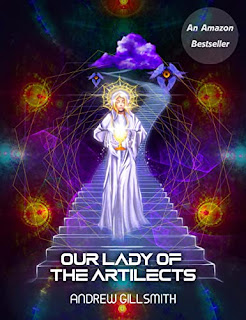https://www.amazon.com/dp/B09Z7F81WD
Our Lady of the Artilects looks like an exciting story. What can you tell us about it?
It’s been called “Catholic cyberpunk,” sort of a “the Exorcist meets Westworld” kind of story.
It begins with the revelation that some artilects (androids) have recently experienced what appears to be a somewhat apocalyptic Marian apparition, similar to the one at Fatima in the early 20th Century. Authorities hope to dismiss it as a hoax, but then an artilect belonging to Amari Okpara, the wealthiest man in Africa, shows up at a basilica claiming to be possessed. The Church sends Fr. Gabriel Serafian–an exorcist who used to be a neuroscientist–to Nigeria to investigate.
He pretty quickly finds himself swept up into a conspiracy of global, and possibly supernatural, scope.
Any plans to turn it into a series?
Yes, I’m working on the sequel, which will be titled “The Lucifer Particles.” It will pick up shortly where OLotA leaves off. Depending on what happens, there may also be a third book.
How long did it take you to write Our Lady of the Artilects?
That’s always such a loaded question! The short answer is 7 months. The long answer is “my whole life.”
This is a deeply personal story of faith and doubt, the intersection of science and belief. I grew up an evangelical Protestant, studied religion in college, and lost my faith. I found my way back to it through science and ultimately converted to Roman Catholicism about 10 years ago. I ended up going back to school for a master’s degree in data science–I’m about halfway through the program. The book is really a reflection of all those experiences.
What inspired you when writing Our Lady of the Artilects?
I’m a huge fan of the writings of Malachi Martin. He passed away some years ago, but he wrote some of the most chilling and accurate accounts of actual exorcisms ever recorded. He was a towering intellect who also had some unique insights into the organizational structure of the conciliar Church and what I would call “sacramental history.”
Beyond that, my earliest memories of reading are of JRR Tolkien and CS Lewis. Later on, I discovered metaphysical sci fi writers like Frank Herbert, Philip K Dick, Asimov, and the great Walter Miller, who wrote A Canticle for Leibowitz–the gold standard for Catholic sci fi.
I’m also a wannabe neuroscientist, and I think that VS Ramachandran is one of the greatest scientific minds of the last 100 years. That’s saying a lot, given how far science has progressed in that time! His theories on mirror neuron evolution and the neuroscience of aesthetics were very influential.
Finally, there is a Sufi Shayk in Canada named Nur Muhammed who has fascinating ideas on the moral dimension of modern digital culture. I really enjoy his YouTube videos.
Can you tell us a little about Father Gabriel Serafian?
He’s a complicated character, and I hope an interesting one. He had some neurological issues as a child, which led him to get “noetic implants” at an exceptionally young age. He had a brilliant career as an artificial neuroscientist and coder and was engaged to an astrophysicist. When he and his fiancee had a miscarriage, he left his old life behind to join the church, where he found himself apprenticed to an eccentric Irish exorcist. He’s naturally curious, but he struggles to reconcile his scientific knowledge and his commitment to God.
How did you come up with the story in Our Lady of the Artilects?
It’s been on my mind for quite some time. I’m interested in the ethical and spiritual issues around transhumanism. As a Roman Catholic, I think transhumanism will be the single greatest challenge to St. Pope John Paul II’s theology of the body in the second half of the 21st century. So many moral arguments are rooted in the idea that human nature is immutable. Transhumanism strikes at the very heart of that, and it will require a vigorous response from not only Catholics but Muslims, Protestants, Hindus, Buddhists, and ethical humanists alike.
Did anything stick out as particularly challenging when writing Our Lady of the Artilects?
I wanted above all to write a book that honestly dealt with questions about faith and science, and what it means to be a human in the digital age. I have a point of view, of course, but I wanted to do justice to all of the arguments. There’s nothing worse than a preachy book!
What do you like to do when not writing?
I work in digital marketing, so that keeps me pretty busy. When I’m not working, I’m with my wife Cheryl and my two young boys Finn and Rowan. I really should find a hobby.
Where can readers find out more about your work?
The book is available on Amazon at the following link: https://www.amazon.com/dp/B09Z7F81WD
I also have a website at www.andrewgillsmith.com


No comments:
Post a Comment